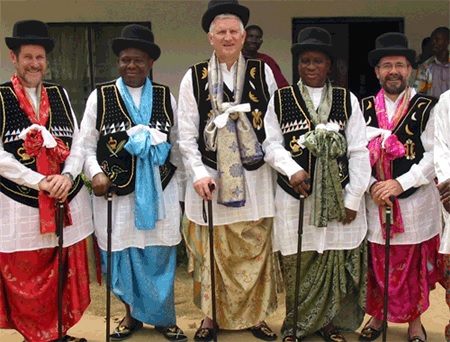Rural Round-up: a history of the WONCA Working Party on Rural Practice

Ian Couper (centre), Roger Strasser (left), Jim Rourke, and John Wynn-Jones have published a history of the WONCA Working Party on Rural Practice (WWPRP) 1992 to 2012 in the journal
Rural and Remote Health. It includes some fascinating memories and conclusions about the state of play at the moment.
Photo: Figure 3 from the article - Pictured after their investiture as honorary chiefs by the Okoyong community, near Calabar, Nigeria, during the eighth conference (from L to R), Dr Roger Strasser (Canada), Dr Ndifreke Udonwa (host organiser, Nigeria), Dr Ian Couper (chair WWPRP, South Africa), Dr Victor Inem (Nigeria) and Dr Bruce Chater (Australia). This has become an iconic image for the WWPRP – hardly a conference goes by without this being shown at least once!
Citation: Couper I, Strasser R, Rourke J, Wynn-Jones J. Rural health
activism over two decades: the Wonca Working Party on Rural Practice
1992-2012.
Rural and Remote Health 15: 3245. (Online) 2015. Available:
http://www.rrh.org.au
The authors' conclusion in the article: Much has been achieved, but there is still much more to do. There is a need to review and consolidate, but also to move forward in terms of new challenges. The importance of rural medical education has been accepted, with the WWPRP’s Guidebook on Rural Medical Education having now being published, but equally there is a need to intensify support for rural practitioners on the ground and to ensure the 'rural proofing' of policies adopted by governments as key to the goal of Health for All Rural People.
New areas that need to be tackled in relation to rural communities include the global pandemic of chronic non-communicable diseases, the continuing problems of HIV–AIDS and tuberculosis, particularly in developing countries, the impact of climate change on the rural environment and the health of rural people, and the ongoing effects of the global financial crisis.
The WWPRP has functioned effectively because of the passion of its members, who are committed to the health and wellbeing of rural communities, and the relationships that have been forged because of shared experiences and goals. The working party is striving towards recruiting members who are younger, from a greater diversity of backgrounds and from all parts of the world, as well as being balanced from a gender perspective. Just as new technology (the conference call and the fax machine) helped connect WWPRP members and rural doctors around the world in the early years, the WWPRP now uses available social media communication technologies to link rural doctors who cannot attend traditional meetings. There is no doubt that new ways will be found in the future that will support a new group of passionate individuals to join together to impact on the delivery of rural health care over the next 20 years. There is also no doubt that much work still needs to be done.
Abstract
The Wonca Working Party on Rural Practice (WWPRP) was
formed in 1992 in response to the realization that rural healthcare
faced many serious and similar challenges around the world. Over the
years the members of the committee have come from many different
countries but found inspiration and strength in developing and sharing
educational and health system innovations that could be modified and
applied to different rural settings.
The 11 world rural health
conferences organized by the WWPRP over the first two decades since it
was founded brought together a range of people, from rural doctors and
other front-line healthcare workers to administrators and educational
leaders, who connected with and learned from each other to advance rural
health care around the world. The WWPRP policy documents and conference
consensus statements have been important in shaping rural health care
in a number of different contexts, and have led to issues of rural
health care rising to prominence on the world stage.
The WWPRP
has throughout been an activist lobby group with a focus on the rural
communities it serves rather than its members, and enters its third
decade with much left to be done.
|
view and print full article